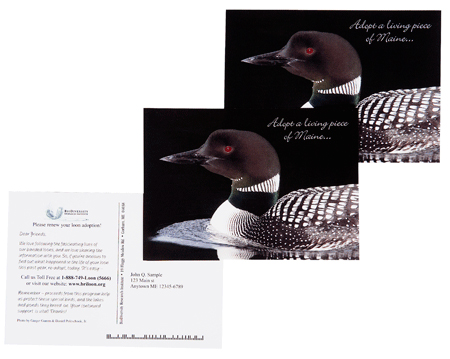In light of our recent announcement to release weekly success stories leading up to Graph Expo, I wanted to share how a 2010 Best-of-the-Best Contest winner, DMM Inc., helped a non-profit organization by increasing donations and helping preserve our wild-life with a photo publishing direct marketing campaign.
Located in Scarborough, Maine, DMM Inc. is a direct marketing communications firm that specializes in fulfillment solutions, transactional promotional, and direct marketing campaigns. DMM was approached by the BioDiversity Research Institute (BRI) to help create and produce their annual Adopt-a-Loon fundraiser, all the while making it more successful then the past year’s campaign. The mission of BRI is to assess emerging threats to wildlife and ecosystems through extensive and collaborative research, and to then provide decision-makers with the necessary data to advance environmental awareness. To help accomplish these objectives, DMM worked with BRI to create a direct marketing campaign targeting both past and present donors, as well as a version targeting new prospects.
[youtube]http://www.youtube.com/watch?v=kfszn4YaMVQ[/youtube]
One of the immediate challenges DMM faced was that the imagery to be used on the postcard was real wildlife photography of loons, which consisted of dark colors and very little contrast. This translated into an incredibly high area coverage of black. In order for this to meet the quality expectations of BRI, the final output was going to need consistent ink distribution. Further complicating matters was BRI’s desire for this project to stay within the mission statement of the organization and be produced as sustainably as possible.
DMM knew that they could rely on their Xerox iGen4 Digital Press to meet the quality standards which BRI expected. By using non-toxic dry inks and 97% recyclable components, the iGen4 also helped DMM meet the sustainability objectives that characterize BRI as an organization. DMM took it even further by choosing to produce the campaign on FSC-certified paper, as well as designing the cards to fit six-up on the sheet, further adding to the sustainability story.

The campaign itself was produced using GMC Software Technology’s PrintNet T, which is a variable composition software used for the creation and production of high impact, personalized campaigns. Using database information provided by BRI, two versions of the postcard were created. The version targeting past and current contributors provided information for how the donor can find out what is happening in the life of their adopted loon, and also requests for a renewal of their adoption. The version targeting prospective donors provides information on how they can help wildlife conservation by adopting a loon in the name of a loved one.
By effectively segmenting their database, using the right messaging, and creating an aesthetically pleasing postcard; DMM was able to help BRI accomplish their goals by achieving a 6% response rate and increasing donations by 14.4% over 2009. The Adopt-a-Loon campaign is an excellent example of how the use of personalization, even in a simplistic manner, can be very effective when done properly.
To see more successful direct marketing campaigns, and to learn more ways to get the most out of your direct marketing efforts, I strongly suggest checking out our Direct Mail section on the Digital Print Hot Spot Blog.
If you’d like to receive a complementary 2010 Best-of-the-Best Case Study spiral bound book printed on our iGen4, be one of the first 10 readers to add your comments below!
Also, learn more about this campaign from DMM Inc., please read the case study. If you are interested in ways you can help foster wildlife conservation, awareness, and education, visit the BioDiversity Research Institute. And for more information on our content, visit the Xerox Best-of-the-Best Contest page.
Stay tuned for another outstanding customer success story to be featured next week!
14 Comments
Comments are closed.


As a former photographer, and now a Xerox sales rep. I am always interested in case studies that show how Xerox can be useful in all aspects to digital printers and users, keep them coming. I use these in my sale calls.
I am keen to share the success stories of customers using iGen4 or other Xerox machine in Photo Industry. Do keep me posted on the same.
Inded, the iGen4 black is great to create great effects. Like this campaign, as it is easy, straight forward and clear. Looking forward to see more examples in future which shows what is possible with right technology behind and good thinking. Inspiration for Europe.
Christian – thank you so much for stopping by and checking out our blog! The iGen4 is terrific in terms of image quality and productivity.
If you’re looking for more examples of what talented individuals are producing in the industry today – you’ve come to the right spot! We are posting a new success story each of the next 4 weeks, and more to come after that!
It’s case studies like these that teach not only the benefit of quality but also a creative way for an organization to raise funding. It’s killer apps like this that make digital printing more and more effective. Thanks for sharing. Keep ’em coming!
Photo publishing campaigns really help.It is a good sign that it has helped increase donation amount by 14.4%.Case Studies gets people interested.Keep them coming.
Being able to present a case study to prospective Xerox customers moves the sales process to a much higher level. It’s hard for a customer to not acknowledge successes, especially in their own industries. I look forward to everyone you present on this blog.